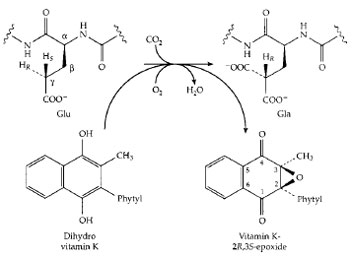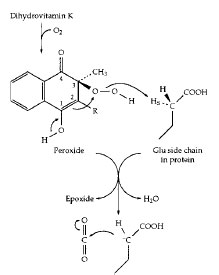Vitamin K and Blood Clotting
Vitamin K (phylloquinone, Fig. 3), the only form of vitamin
K found in plants, functions as an electron carrier in
the photosynthetic membranes of the chloroplasts. There it
serves to carry electrons from the photosystem I receptor in
an electron transport chain related to that of mitochondria.
The latter utilizes ubiquinone rather than phylloquinone.
Some photosynthetic bacteria utilize menaquinone, in
which the number of isoprenoid units in the polyprenyl
side chain is greater. In the human body vitamin K has
a quite different and specialized function in the modification
of the side chains of glutamic acid units in a small
group of proteins. Among these are prothrombin and other
blood clotting proteins. Selected glutamic acid side chains
(at 10 positions near the N-terminal end of the prothrombin
chain) are modified by addition of an extra carboxyl
group at the gamma (or C4) position of the side chain
to give γ -carboxyglutamate (Gla) units. The side chain
now contains two negatively charged —COO
− groups and
is able to better bind to calcium ions (Ca
2+), which help
bind the clotting factors to the phospholipid membrane
in the blood clotting complex. Formation of Gla requires
both vitamin K and O
2, as indicated in Fig. 21. Here the
quinone form of vitamin K has been reduced to the dihydro
form. It has been shown experimentally to be converted
to the epoxide derivative as the glutamyl (Glu) side chain
is converted to that of Gla. One possible mechanism is
depicted in Fig. 22. The O
2 molecule has added to the
dihydro-vitamin K to form a peroxide which is used to
generate an HO
− ion in the active site where it is in a position
to remove the hydrogen in the γ position to form
H
2O. The resulting anion adds to CO
2 to form the Gla.
 |
| Figure 21 Scheme showing the coupling of O2-dependent oxidation
of vitamin K to its epoxide to the carboxylation of the γ-
carbon of a glutamyl side chain to a γ-carboxyglutamate (Gla)
side chain. One atom of the O2 enters the epoxide while the other
enters H2O. |
 |
| Figure 22 A plausible mechanism by which vitamin K acts as
a coenzyme to assist in the formation of γ -carboxyglutamate side
chains in proteins of the blood-clotting system. |






